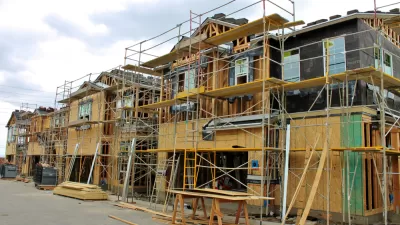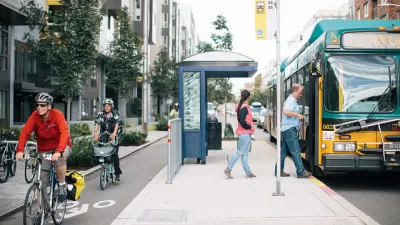As cities build upwards in an effort to create more housing and increase walkability, research shows that tall buildings intensify heat and contribute to increased carbon emissions.

"A report by the United Nations’ Intergovernmental Panel on Climate Change released on Monday looked at the relationship between housing, building structures, and broiling city blocks and found that deaths from heatwaves — like the one in Chicago [in 1995] — are not a coincidence," reports Adam Mahoney. The "report found that the single biggest contributor to amplifying heat and warming in cities is 'urban geometry,' the relationship between city layouts, building construction, and density," and that "[t]he main problem driving the so-called 'heat-island effect' is tall buildings." Because of this, "[u]rban centers can range as much as 22 degrees warmer than nearby rural areas."
[C]ities and states across the country — in Ohio, New York City, and back in Chicago, developers are building taller affordable housing, going up, not out, in an effort to create density, walkable neighborhoods where infrastructure costs are lower and jobs, stores, and homes are closer together. The trick is finding a solution that offers everyone safe and quality housing without overheating the planet.
John Mandyck, CEO of the Urban Green Council in New York City, says "[c]ities could create gardens in the sky, which have successfully offered natural cooling and improved air quality in cities like Chicago, as well as planting trees and bushes to shade sidewalks and streets." Other solutions include reflective roofing systems, which in New York City alone prevent "an estimated 2,500 tons of CO2 emissions every year."
While building up may mitigate the housing crisis, "it’s not even one percent of the solution to our environmental problems because it adds challenges even as it mitigates some," says Rick Cole, executive director of the Congress for New Urbanism. "More than 25 years after that first Cabrini tower came down, U.S. cities are much more equipped to tackle housing problems and the climate crisis, but action requires political willpower and individual sacrifices."
FULL STORY: Tall buildings: Good for the housing crisis, bad for the climate crisis

Planetizen Federal Action Tracker
A weekly monitor of how Trump’s orders and actions are impacting planners and planning in America.

Congressman Proposes Bill to Rename DC Metro “Trump Train”
The Make Autorail Great Again Act would withhold federal funding to the system until the Washington Metropolitan Area Transit Authority (WMATA), rebrands as the Washington Metropolitan Authority for Greater Access (WMAGA).

The Simple Legislative Tool Transforming Vacant Downtowns
In California, Michigan and Georgia, an easy win is bringing dollars — and delight — back to city centers.

The States Losing Rural Delivery Rooms at an Alarming Pace
In some states, as few as 9% of rural hospitals still deliver babies. As a result, rising pre-term births, no adequate pre-term care and "harrowing" close calls are a growing reality.

The Small South Asian Republic Going all in on EVs
Thanks to one simple policy change less than five years ago, 65% of new cars in this Himalayan country are now electric.

DC Backpedals on Bike Lane Protection, Swaps Barriers for Paint
Citing aesthetic concerns, the city is removing the concrete barriers and flexposts that once separated Arizona Avenue cyclists from motor vehicles.
Urban Design for Planners 1: Software Tools
This six-course series explores essential urban design concepts using open source software and equips planners with the tools they need to participate fully in the urban design process.
Planning for Universal Design
Learn the tools for implementing Universal Design in planning regulations.
Smith Gee Studio
City of Charlotte
City of Camden Redevelopment Agency
City of Astoria
Transportation Research & Education Center (TREC) at Portland State University
US High Speed Rail Association
City of Camden Redevelopment Agency
Municipality of Princeton (NJ)





























